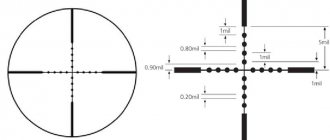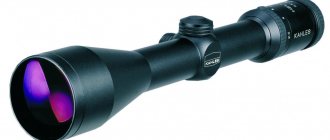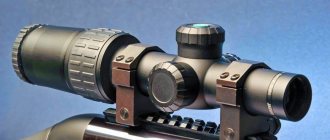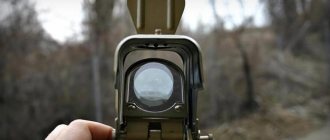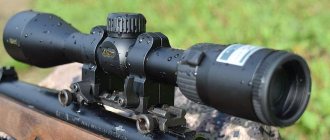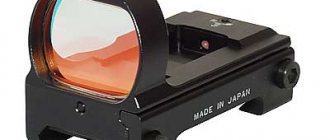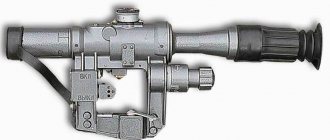Small arms are the main type of weapons in all armies of the world. It is used in most armed conflicts. However, the real effectiveness of its use is based not only on the characteristics of the weapon itself or the level of professionalism of the fighters, it also depends on the quality of the sighting devices installed on the weapon. Nowadays, the military industry produces a full range of different types of sights for such weapons. Sights can be open, optical, collimator, night, and thermal imaging.
Open sight
An open sight consists of a rear sight and a front sight, which are located on the same axis. The aiming process occurs when the rear sight slot is visually aligned with the front sight and the target itself. If aiming is done correctly, the front sight will be in the rear sight slot in such a way that the gaps on the left and right sides will be the same. In this case, the upper edge of the front sight should be at the same level as the upper cut of the rear sight. While zeroing the weapon, the aiming bar is adjusted horizontally and vertically.
Sometimes there are adjustable front sights. In recent years, fiber optic flies with bright green or red colors have become widespread. This innovation simplifies the process of aiming in the twilight. An open sight can be convenient when shooting at moving or static targets.
Open sight: pros and cons
Plus:
- Cheapness;
- Simplicity of design;
- Light weight;
- Easy maintenance;
- Strength.
Minus:
- Inconvenient aiming;
- Low accuracy/accuracy of fire.
Ring sights
Another type of mechanical sighting devices is ring-shaped (in the old literature, through or orthopedic). As mentioned above, the first type of sight used by man was the ring sight, which was used back in the Middle Ages on crossbows and crossbows. Schematically, a ring sight consists of a small disk with a round hole in the middle and a base on which the disk is mounted (Fig. 10). The walls of the disk surrounding the hole are relatively small, and the disk is more like a ring, hence the name of the sight - ring. The base supports the ring from below. The ring sight is placed on the weapon so that during aiming it is as close to the eye as possible, but during recoil it does not reach the shooter’s face. Aiming consists of, looking through the sighting hole, aiming the top of the front sight at the aiming point. The large length of the aiming line (that is, the distance from the sight to the front sight) and the small size of the hole in the ring do not allow a significant error in aiming. In addition, the center of the hole is better illuminated, and the eye involuntarily tends to place the top of the front sight in the middle of the aiming hole; This is done automatically, without requiring much effort and without distracting the shooter’s attention. This is the main advantage of this type of sighting device.
Rice. 10. Ring sight mounted on a Winchester rifle, model 1886
The ring is usually located 6-12 cm from the eye, that is, much closer to the distance of best vision, which is 20-25 cm for normal adult vision. A healthy eye cannot accommodate such a close distance and, therefore, will not clearly see the edges of the aiming hole . But this will not affect the accuracy of aiming, since to find the middle of a round hole, it makes no difference whether its edges are clearly or indistinctly visible, and for correct aiming through a ring sight, all that is required is that the top of the front sight be in the middle of the aiming hole. Thus, there is no need to accommodate the eye to the sight.
Another advantage of such sights is that, thanks to the small size of the ring with a relatively narrow rim, the field of view is almost completely not blocked. An open field of view, in turn, allows you to quickly find both stationary and moving targets and not lose them while aiming; despite the recoil, it is possible to monitor the results of the shot and at the same time not leave the surrounding area unobserved. This is another of the significant positive qualities of the ring sight, which allows it to be successfully used on a wide variety of hunting with bullet weapons.
The aiming hole, like the entire diaphragm, absorbs a certain amount of light rays, and the smaller the hole, the more light rays are absorbed and the less illuminated the objects viewed through the hole appear. All other things being equal, ring sights are inferior to open sights in this indicator. Therefore, for shooting at dusk, it is advisable to install a ring with an increased diameter of the aiming hole, although this somewhat reduces the aiming accuracy.
Rice. 11. Varieties of ring sights
There are many ring sight systems. The simplest ones consist only of a ring and a base in the form of a thin stem, or rod (Fig. 11 a), and do not allow the position of the ring to be changed in height and to the sides. There are sights that allow the ring to move only in height. In the system that was most popular at the end of the 19th and beginning of the 20th centuries (Fig. 11 b), lifting is carried out by rotating a coupling placed on a tube into which the base of the ring fits. On the base there are divisions showing the height of the ring. The tube with the base is pivotally connected to the block and, if necessary, can be lowered to a horizontal non-working position. The original design is shown in Fig. 11c. A crosspiece fixed on an axis with rings at the ends is placed in the longitudinal groove of the base. The length of each crosspiece is selected so that it corresponds to a certain shooting distance. To install the required sight, simply turn it vertically to place the ring at the required height. In the working position, the base of the ring is secured with a spring latch with a ball. This latch is put on the front side of the crosspiece axis and squeezes the ball into the recess on it. More complex sights have special devices for very precise movement of the ring, both vertically and horizontally (which facilitates zeroing and allows for the necessary corrections to be made in case the bullet is deflected by the wind).
Optical sight
An optical sight is considered more advanced than an open sight. Its use increases accuracy and accuracy when firing. This occurs due to the visual magnification of the target, as well as the exclusion of reaccommodation (change of focus) of the eyes. In an optical sight, the aiming mark with the image of the target are combined in the focal plane of the lens of the optical system. Most optical sights have some special features. For example, a limited field of view (this makes it difficult to find targets), as well as a constant diameter of the exit pupils, which, based on observation conditions, vary from 2 to 8 mm.
In addition, when observing a target using an optical sight, the eye pupil is aligned with the exit pupil of the device, otherwise errors may occur during the aiming process. The red dot sight does not have such shortcomings.
An optical sight is a complex optical device that greatly increases the accurate aiming of small arms at a target, which leads to greater efficiency when shooting. Such sights for small arms can be installed on smooth-bore or rifled types. Structurally, optical sights resemble small telescopes.
Optical sight: pros/cons
Plus:
- Convenient aiming;
- Increasing the size of the visible target;
- High accuracy/accuracy when shooting.
Minus:
- Heavy weight can lead to unbalanced weapons and, consequently, to fatigue of the shooter, especially when shooting while standing;
- Expensive;
- The device is complex, so zeroing in this sight often causes inconvenience for a novice shooter, as does setting it up;
- Does not apply to pistols.
How to choose a scope depending on your goals
If you are a beginner fan of pneumatic guns and do not plan to seriously engage in shooting, then it is quite possible that you will be satisfied with a simple mechanical sight that comes with almost any weapon. But most often, such devices will only be used as an addition to the main sight, which will have to be purchased separately.
If you use a CO2 pistol or semi-automatic pistol as an airgun, then it would be best to install a laser designator or tactical flashlight on them. The fact is that these types of weapons are best suited for shooting at short distances, and the laser center has established itself as a simple and intuitive device that works smoothly at short distances.
Collimators are suitable for installation on semi-automatic machines running on carbon dioxide or on Airsoft pneumatics. They are used for shooting at short distances - up to 25 m. Using them at long distances is problematic due to the size of the aiming mark, which often covers the target itself. In addition, in inexpensive products this is hampered by parallax and poor build quality of the device.
Now let's move on to optical sights. It is believed that those devices that are equipped with a magnification of less than 9x should be classified as hunting - their entrance lens diameter is not very large, and they are inexpensive. But this price is due to limited functionality: there is no possibility of parallax adjustment, and the quality of the glass in the lenses cannot be called good either.
Sights with a magnification factor of 10 to 16x can be called universal: these devices are suitable for both shooting at paper targets and small moving targets. Make sure that the entrance lens diameter is at least 40mm - this will ensure that enough light penetrates and the image will be bright. Among these models you can choose devices for hunting, sports and entertainment. 10-16x scopes are suitable for long-range shooting.
If the sighting device has a magnification of around 24x, this means that such a product is best used for sports shooting at paper targets. In order for such a scope to produce a high-quality image, it is necessary that the diameter of the front lens be at least 50 mm. It’s good if the device itself is equipped with a special focusing wheel - this makes it easier to use.
Sights with high magnification (from 32x) are the lot of professional athletes. If you are looking for a device for hunting or just amateur shooting, it is better to pay attention to other models. Firstly, such devices will be uncomfortable for inexperienced shooters: their exit pupil diameter is small, which means they will need to get used to using such a sight. Looking into it, initially you can only see a cloudy and dark picture. The second disadvantage of high magnification scopes is their weight and dimensions: often their weight exceeds 1 kg. In addition, such devices increase the vibrations of the rifle from the slightest movement, including the shooter’s pulse, so there is a risk of “aiming” and missing, which would not have happened if you had not used this device.
Important information for owners of spring-piston rifles: the fact is that such weapons have strong recoil, and due to high vibration when fired, flimsy sights are quickly destroyed. Often this requires literally hundreds of shots. Therefore, when buying a scope for an SPP rifle, follow some simple recommendations:
- give preference to products with an entrance lens diameter of no more than 40 mm;
- Choose scopes with constant magnification: such devices are more reliable and are more likely to withstand strong recoil when shooting.
- When attaching an aiming device to your weapon, use a monoblock bracket.
Collimator sight
A red dot sight is considered the best sight when shooting at moving targets. It was first used in aviation, because the pilot’s life depended on the speed of aiming, as well as the correct lead when shooting at fast-flying targets. Such an application for small arms was found relatively recently.
During the aiming process, the shooter aligns the reticle with the target. At the same time, his eye focuses exclusively on two objects: the luminous mark and the target. After the shooter moves his eye away from the sight, the aiming mark will visually remain on the target and move relative to the shooter's gaze. Thus, for accurate fire, the position of the weapon relative to its eye is not so important. This creates many advantages when shooting handheld, while moving, at fast-moving targets, etc. Collimator sights have proven themselves well for hunting with smooth-bore weapons.
The positive properties of a collimator sight (dot sight) are achieved due to its special design. Thus, the aiming mark is reflected on the sight lens in the form of a light source projected onto it. Through this lens, the shooter observes the target by aligning the target with the aiming mark.
Reticle marks can be very diverse: from a simple red dot to a figure with a certain number of circles of different diameters, simplifying the process of calculating lead when shooting at moving targets. Most scopes have low magnification. As a rule, the magnification of a sight can be no more than 2 units, which are indicated by manufacturers.
Types of collimator sights
Collimator sights differ by type:
- Open;
- Closed.
In closed collimator sights, the light source is located inside the housing, most often made in the form of a tube. A reflective lens at the front forms the objective, and an additional lens at the back of the tube forms the eyepiece. Thus, the light source is completely closed from the external environment and protected from dampness and contamination. However, this comes at the cost of not having the best visibility, as well as a reduced field of view through the scope.
Open red dot sights have only one lens and an open light source. This design feature provides better visibility to the shooter, since the target is visible through a small frame with one lens. However, this design is easily subject to contamination and weather conditions, which can distort the projection of the image onto the lens.
The sights are attached directly to the receiver. Fastenings are divided into two types:
- Dovetail;
- Weaver.
Collimator sight: pros/cons
Plus:
- Convenient aiming at moving and static targets;
- Compactness – small sight;
- Light weight;
- Possibility of long-term training without eye fatigue;
- Convenient use on pistols.
Minus:
- Open sights can become dirty.
Top 10 sights according to the Steel&Gun online store
We have prepared for you a useful selection of sighting devices suitable for a variety of purposes. Here we have collected optical and collimator models from reliable manufacturers. When preparing the rating, we used customer reviews and the expert opinion of our consultants. For convenience, we have collected all the models in a small summary table. Below you will find a detailed description of each device:
| Model name | Advantages |
| Collimator sight Veber Wolf Reflex 125 RD |
|
| Sight with bracket, 3-7x20 (cross) |
|
| Pneumatic sight Veber Brave Hare 3-7×20 C |
|
| Optical sight NORIN 3-7x20 |
|
| Collimator sight Veber Wolf Reflex 128 RD |
|
| Veber Black Fox 123 RD Weaver |
|
| LEAPERS UTG 1x30 Compact, closed on Weaver, illuminated circle with dot |
|
| Collimator LEAPERS 5TH GEN 1x32 4″ ITA, closed |
|
| Target Optic collimator 1x22M closed type on Weaver, green/red dot |
|
| Optical sight NORIN 4×28 |
|
Collimator sight Veber Wolf Reflex 125 RD
Buy collimator sight Veber Wolf Reflex 125 RD
Veber Wolf Reflex 125 RD is a red dot sight from a famous manufacturer. Veber has been making scopes for a long time and has earned an excellent reputation in this field. Veber Wolf Reflex differs from most collimators in its dimensions - only 66 mm. So, it attaches to the Weaver bar and does not take up much space. The collimator body is made of durable aluminum alloy with a non-reflective coating and stands the test of time. The sight can withstand recoil from most pneumatic actuators, with a maximum muzzle energy of 7000 J.
Sight with bracket, 3-7x20 (cross)
Buy a sight with a bracket, 3-7x20 (cross)
Optical sight with bracket from Target Optic. Designed for weapons with low recoil. The magnification ratio varies from 3 to 7 times. Changes in magnification are made using a wheel located near the eyepiece. Lens diameter – 20 mm, tube diameter – 18 mm. The reticle is a classic cross. There is no backlighting or parallax adjustment. The sight is mounted on a dovetail rail.
Pneumatic sight Veber Brave Hare 3-7×20 C
Buy a pneumatic sight Veber Brave Hare 3-7×20 C
Veber Brave Hare 3-7×20 C pneumatic sight with smooth magnification from 3x to 7x weighs only 235 g. This sight contains all the necessary characteristics; it is a truly successful combination of quality and price. At 3x magnification, closest focusing is at a distance of 4 meters. Equipped with optical glass, aluminum body. The protective covers for the sighting drums are plastic. The scope comes with dovetail rings, a microfiber cloth, protective caps and an instruction manual. The sight length of this model is 285 mm, the maximum dual energy for pneumatics is 7.5 J. The lens has a diameter of 20 mm, which allows you to obtain good image quality.
Optical sight NORIN 3-7x20
Buy optical sight NORIN 3-7x20
The NORIN 3-7×20 closed-type optical sight is one of the most inexpensive on the market among other sights of this type. The sight is suitable for economy-class weapons with low and medium power. The lens diameter is 20 mm, and the magnification factor can vary for a specific type of shooting (from 3 to 7). The body is made of durable aluminum and has protective properties against moisture and dust.
Collimator sight Veber Wolf Reflex 128 RD
Buy collimator sight Veber Wolf Reflex 128 RD
The Veber Wolf Reflex 128 RD collimator sight is particularly compact. Its weight including the battery is only 53 grams. It is very stylish in appearance - the aluminum alloy is coated with a black non-reflective anode coating. This material also makes the scope quite durable. You can be sure that it will serve you for a long time.
This is an open type sight; it is installed on a weapon using a removable adapter, which is already included in the package. The sight is used in conjunction with air guns and firearms. The image is always clear and bright, the intensity of the red aiming dot is adjusted both by the light sensor and in manual mode. The main reason why you should buy a Veber Wolf Reflex 128 RD red dot sight is the ability to shoot while keeping both eyes open. An affordable and high-quality device will leave you satisfied with the result.
Collimator sight Veber Black Fox 123 RD Weaver
Buy red dot sight Veber Black Fox 123 RD Weaver
The Veber Black Fox 123 RD Weaver collimator sight is used as an accessory for airsoft weapons with a Weaver-type guide bar. The product has 5 brightness modes, adjustable by button, so you can choose a comfortable mode for use. The optics provide 1x magnification, and aspherical optics do not distort the image. The red 3 MOA dot reticle remains in place regardless of eye position relative to the line of sight. The sight body is made of extruded aluminum alloy with a black non-reflective anode coating, which guarantees long service life of the sight. A CR2032 lithium battery allows you to use the accessory for more than 300 hours. Small dimensions and weight do not at all weigh down the weapon on which the sight was mounted.
Collimator LEAPERS UTG 1x30 Compact, closed on Weaver, illuminated circle with dot
Buy collimator LEAPERS UTG 1x30 Compact, closed on Weaver, illuminated circle with dot
Collimator LEAPERS UTG 1x30 Compact is a compact closed-type collimator sight. Can be installed on carbines, pump-action shotguns and rifled weapons. High-quality optics with high light transmission provide a clear and bright image, allowing you to observe the target in the twilight. The collimator can withstand various weather conditions, such as rain or strong wind. When purchasing a LEAPERS UTG 1x30 Compact, the kit includes covers for the lens and eyepiece, a CR2032 3V battery, an optics cloth, and instructions. A wide viewing angle and customization options allow comfortable observation through the sight. Equipped with a Weaver/Picatinny rail. There is backlighting in 5 brightness levels, the reticle is a circle with a dot. The body is made of high-strength aircraft steel. Not suitable for use on 12 gauge, 7.62x54 and larger weapons.
Collimator LEAPERS 5TH GEN 1x32 4″ ITA, closed
Buy collimator LEAPERS 5TH GEN 1x32 4″ ITA, closed
When using the LEAPERS 5TH GEN 1x32 4″ ITA collimator, there is no need to close the second eye. When shooting, the gaze is focused on the target. The device was created specifically for aimed, accurate shooting at short distances. Can be used for driven hunting. The dot brand has 2 backlight colors (green and red), each color can be adjusted separately. The adjustment is smooth. The collimator body is made of aluminum. The sighting screws have a graduation value of 13mm/100 m. For reliable fixation to the body, fixing bolts are used (the kit includes a spare screw and 2 hex keys).
Target Optic collimator 1x22M closed type on Weaver, green/red dot
Buy Target Optic 1x22M closed collimator on Weaver, green/red dot
Compact and reliable closed-type collimator sight to improve the quality and speed of aiming during shooting. The color of the reticle is red/green. Thanks to the backlight, the sight can be used at any time of the day. The backlight is powered by a CR2032 3V battery. Waterproof - up to 10 m for 30 minutes. Can operate at temperatures from -30 to + 60 C. Made of reliable aluminum alloy.
Optical sight NORIN 4×28
Buy optical sight NORIN 4×28
An optical sight from the manufacturer NORIN with a 4x magnification and a lens diameter of 28 mm is simple and easy to use, so it is perfect for beginners who want to get acquainted with optical accessories for weapons. The Duplex cross-shaped sighting mark is adjusted using special screws horizontally and vertically. The kit includes caps for the lens and eyepiece.
The scope body is made of durable aircraft-grade aluminum, which does not weigh down the weapon at all and provides the necessary strength to the product. The device is designed for medium-power airsoft weapons. The design rings are designed for mounting on a dovetail-type guide bar. This product would be a good choice for a beginning airsoft player with an existing rifle or machine gun.
Today, the market is full of a variety of sight models, and in order to choose the one that’s right for you, you need to decide for what purpose you are buying it, in what conditions and with what weapon you plan to use it. In our Steel & Gun online store you will find models of a wide variety of modifications, and if you have problems with the choice, our experienced sales consultants will always be happy to help you.
Features of hunting scopes
For anyone, not necessarily a novice hunter, choosing the right scope is extremely important.
The selection of a scope is carried out taking into account many circumstances, so you should approach this important event with the utmost caution. Experts recommend that you first familiarize yourself with the existing types of sighting devices for hunting. However, it is still advisable to select a small scope in order to have time to fire the long-awaited shot in a timely manner in the event of a sudden face-to-face collision with a wild animal or game.
A variety of hunting scopes
Hunting scopes mainly come in the following varieties:
- Optical;
- Collimator;
- Laser;
- Night vision.
All of the above types of hunting scopes have their advantages and disadvantages, as well as operating features and a wide variety of effectiveness, but in general they all meet the same characteristics as shooting scopes.
What is the best holographic sight?
When asked which reflex sight is preferable, experts who have tried many options say that this is the EOTech produced in the States. They make it based on a sight used in the army. Such open-type devices differ from their closest competitors in that their component is a laser optical device. Large selection of marker brightness control (21 stages in total). This ensures accurate shooting even in adverse weather. For those who want to hunt in any conditions, there are also models with a thermal imager and night vision. EOTech uses a sophisticated brand projection system. It is enabled to avoid the parallax effect. Practice shows that even mechanical damage does not affect the operation of this device.
The automatic shutdown mode is used, which gives a significant operating time. Can be programmed for either 4 or 8 hours. Other advantages: compactness, lightness. Recommended for use on 12-gauge shotguns. The batteries used are standard AA batteries, which can be purchased at your local store or ordered online. You can replace them in a minute, without any complicated actions, without subsequent shooting. The disadvantages of such high-quality overseas products include only the high cost (for sophisticated models - 60 thousand rubles and more).
Night sight
The night vision scope has a very complex design. The principle of its operation is based on the effect of increased brightness of the image, as a result of which it becomes visible in dark conditions. Most modern night vision scopes, as a rule, operate in two modes:
- Day;
- Night.
Such a sighting device allows for precise aimed fire, not only at short distances, but also at a long distance from the target. Most sight models are equipped with a zoom system. Thanks to this system, it is possible to increase the size of the object in the lens depending on the circumstances, as well as on what type of weapon is planned to be used for shooting.
The disadvantage of the vast majority of night vision scopes is:
- Extremely high cost compared to others, especially if it is not a night sight;
- The design of the device is complex in all respects, which can fail at any time. This can happen, for example, due to a fall or some other negative external influence;
- The size is not a small scope.
Aperture (ring and diopter) sights.
Ring sights
- similar in design to open ones, but the rear sight is either a shield with a round hole (aperture) or a ring. The front sight is thin, often framed at the edges by a ring or half-ring for ease of aiming. When aiming, the shooter looks through the hole (aperture) in the rear sight, but without focusing on it. Unconsciously aligns the line of sight with respect to the light spot projected by the aperture onto the eye. The sight is adjusted like an open sight. The aiming line is longer than in an open sight, since the rear sight is located close to the eye, which in turn has a positive effect on accuracy. These sights are common on small arms of NATO countries.
Sometimes aperture sights can be found on domestic air weapons. An example is the Izhevsk rifle MP-514.
pros
– good visibility around the target visible through the sight (in an open sight, visibility from below is completely limited). High aiming speed compared to open sights. Better accuracy than with an open sight.
Minuses
– The rear sight limits visibility outside the aperture. Not applicable on pistols.
Diopter sights
- a type of aperture sight. In diopter sights, the hole in the rear sight is very small, the size of the pupil of the eye. Through this hole the target is visible with great sharpness, which is why the sight got its name. The rear sight shield is quite large and completely blocks the view. Of all the mechanical sights, the diopter sight is the most accurate, but has a limited field of view and is not suitable for shooting at moving targets. Thanks to these qualities, it has mainly become widespread in sports bullet shooting.
pros
— accuracy of fire is the best of all mechanical sights.
Minuses
– narrow field of view through the sight. Lack of full view. Unsuitable for shooting at moving targets. Not applicable on pistols.
Thermal imaging sight
Today, a thermal imaging sight is a device without which not a single professional hunt can be carried out. Various foreign and domestic manufacturers offer a wide selection of these devices.
What is a thermal imaging sight
This is a device that allows the shooter to observe a target in conditions of limited visibility.
The thermal imaging sight is used in the following conditions:
- Fog;
- Dustiness;
- High humidity levels.
The operation of this device occurs regardless of the light level, thanks to the use of infrared rays, as well as the calculation of the difference between thermal temperatures. The main design of all thermal imaging sights is optics, which allows firing at long or short distances.
Moreover, this type of equipment is well adapted to many types of small arms. Thermal imaging sight allows you to monitor, as a rule, living, warm-blooded objects:
- Animals;
- People.
Thermal imaging sights: pros/cons
Plus:
- Can be used at night or in dark rooms;
- Easy installation;
- Convenient, easy operation;
- Wide range of uses;
- On more modern models, it is possible to shoot from around the corner.
Minus:
- Few people know, but some models of thermal imaging sights can “blind” the shooter in the event of a sharp flash of light.
You should be aware that there is some difference between thermal imagers and thermal imaging sights. In essence, they are somewhat similar in purpose, but the latter has a more compact size (small sight), as well as a more durable frame base (taking into account shots) in contrast to the thermal imager. Moreover, thermal imaging sights provide faster frame rates and also function without delaying shooting.
Laser pointers
Laser target designators, or laser pointers for short, are suitable for use on weapons not intended for long-range shooting - for example, pistols. They are a laser pointer that can be adjusted in a way that is comfortable for you, adjusting its position vertically and horizontally. The operating principle of laser lasers is as follows: they emit a beam of low power, directing it directly towards the target in such a way that a luminous point appears on the surface of the object.
The laser light can be of any color, but, unfortunately, such sighting devices are limited in range and are only suitable for short-range shooting. Using them in daylight is also problematic: the point is hard to see. But the advantage of such a product is that when using a laser pointer, you can fire from any position, because in the dark the point is visible from everywhere. With this device you can quickly aim, and the field of view is not limited in any way.
Brief conclusions
When choosing “optics” for yourself, for example, a sniper scope, it is advisable to immediately decide on the scope of its tasks. In particular, it is recommended to shoot with a scope with more than 4x magnification using a rest, and only at stationary targets. Rifle sights with less than 4x magnification are useful for firing at moving targets. It should also be remembered that with strong recoil of the weapon there is a risk of getting hit in the eye by the eyepiece.
When choosing optical sights, for example, for a sniper, it is advisable to look through it at a distant object. The image should be clear, sharp, with excellent resolution of details throughout the entire field of view. If the scope is variable multiple, you should make sure that changes in magnification do not cause the crosshair to shift and that a clear image of the target is maintained.
It is advisable to opt for proven models from well-known manufacturers, since optical sights are complex multi-component optical devices. It is impossible to familiarize yourself with most of their technical characteristics without special equipment, for example, to find out resistance to shock overload when fired. When selecting optics, special attention should be paid to the absence of scratches or bubbles in the lenses, as well as dust or other foreign objects inside the sights. Whatever optical device you choose, it is advisable to spare no expense on only the best scopes.
What is eye relief?
Eye relief is the distance between the last lens of the eyepiece and the position of the exit pupil, and therefore the shooter's eye. Typically, the distance is chosen to be 75-80 mm, so that when the firearm recoils, the scope does not injure the shooter.
Interesting materials:
How long does thermostatic yogurt last? How long does tomato sauce last? How long does eau de toilette last in packaging? How long can cottage cheese be stored in bulk? How long does oyster sauce last? How long does salted trout last in the refrigerator? How long is the video from the traffic police exam stored? How long does the City Health Department store an order? How long is an order stored at the Apteka ru pick-up point? How long does an order last in an outlet?
